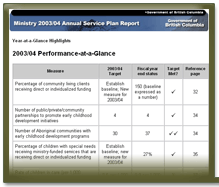 |
|
|
2003/04 Annual Service Plan Report
Ministry of Children and Family Development
Year-at-a-Glance Highlights
The Ministry of Children and Family Development is pleased to report on its performance for the fiscal year 2003/04. In addition to reporting on specific indicators of performance the Ministry would like to highlight its other achievements:
Expanded services
- Strengthened non-custody options for youth in the justice system, including the increased use of restorative justice conferences that bring together an adjudicated youth and person harmed by the offence, families, and others. The ministry has also increased the youth custody Intensive Support and Supervision Program to assist in the re-integration of the young offender to the community.
- Introduced the use of a "Family Development" approach to community complaints about a child being at risk but where the family may need only some assistance with improving parenting skills, coping with specific challenges, or linking with necessary community services. A Family Development approach can include counselling for the parents, substance misuse treatment, or respite services.
- Continued investment in "Alternative Dispute Resolution" (ADR) processes, such as mediation and family group conferencing, to resolve child welfare disputes. Both processes have resulted in better outcomes for children and families, reduced court time and cost to the public service system, and fewer children in care.
- Increased the use of alternate care arrangements with extended family or close friends when a child needs protection.
- Increased the Youth Educational Assistance Fund by $3 million to help youth who grew up in government care to pursue post-secondary education.
- Increased the level of adoption placement.
- Established a $3 million adoption trust fund to assist adoptive families to integrate adopted children into their new homes and communities. The fund also supports research into "best practices" in adoption across North America and new and creative ways to increase the number of adoptive families.
- Funded all 60 provincial school districts through CommunityLink for services to improve the educational performance (academic achievement and social functioning) of vulnerable students.
- Increased assistance to families and communities to improve early learning for young children through early literacy, family development, parental education, outreach and research programs.
- Launched a program to assess school readiness of every five-year-old in BC.
- Began implementation of the Child and Youth Mental Health Plan for British Columbia.
- Strengthened resources for children and youth with mental health disorders, including establishing a toll-free child and youth mental health information line (1 800 661-2121).
- Increased the number of Youth Agreements, which are used as an alternative to bringing high risk youth, age 16-18, into the care of the ministry. "High risk" youth are those that are sexually exploited, have alcohol and drug and/or mental health issues and are currently not living at home. The Agreement is designed to assist the youth in addressing their risk factors and to help them gain independence, return to school, and/or gain work experience and life skills.
Increased flexibility in service delivery
- Initiated new funding options for children with special needs, including Autism Spectrum Disorder (ASD), and for adults with developmental disabilities, to enable them to choose and purchase services that best meet their needs.
- Expanded the implementation of individualized and direct funding models (IF/DF) to adults with developmental disabilities.
- Worked in partnership with other ministries and governments to ensure an integrated approach to dealing with sexual exploitation of children and youth.
- Maintained the lowest reported per capita rates of youth in custody, and of youth on probation, in Canada.
More culturally appropriate services
- Expanded the responsibility of existing Aboriginal organizations and agencies to assist in their growing involvement in responding to child welfare concerns within their own communities. This includes planning, developing, and providing child welfare services for Aboriginal children at-risk and families having difficulties.
- Implemented the Child's Roots Are Forever project with the goal of reconnecting Aboriginal children in the care of the ministry with their families and communities.
- Appointed the province's first Aboriginal Infant Development Program Advisor to assist families of children up to age three who have or are at-risk of a developmental disability or delay, through training in traditional and contemporary parenting skills and building awareness of the importance of early childhood development (ECD).
- Funded Aboriginal Early Childhood Development programs in 37 communities, focusing on: Fetal Alcohol Spectrum Disorder (FASD) prevention; family health, parenting and family support; healthy pregnancy, birth and infancy, and early childhood development for Aboriginal children under six and their families.
Improved service quality and accountability
- Through the use of family- and community-based alternatives to taking children at risk into care, reduced the number of children in care by 517, exceeding the targeted reduction for 2003/04 of 250 children.
- Began the process of accreditation with the Council on Accreditation for Children and Family Services (COA) in four ministry programs: The Maples Adolescent Centre, Youth Forensic Psychiatric Services, Provincial Services for the Deaf and Hard of Hearing (including Victory Hill) and the provincial Youth Custody Centres.
- Supported the accreditation of contracted service providers who deliver a wide range of services.
- Implemented a project to build a sustainable economic foundation for the delivery of services to adults with developmental disabilities and children and youth with special needs through a partnership of private service providers, non-profit service delivery organizations, and government.
- Reduced the number of youth custody centres due to the decreasing numbers of youth requiring custody in the province.
- Implemented new contracting practices to improve accountability for the over $1 billion in contracted services.
- Reduced regulations, as part of government's commitment to cut the "red tape" burden and help front-line staff focus more on clients rather than excessive paperwork.
 |
 |
2003/04
Performance-at-a-Glance |
 |
 |
 |
 |
 |
 |
 |
|
|


